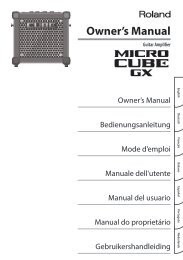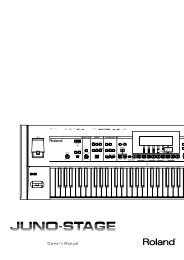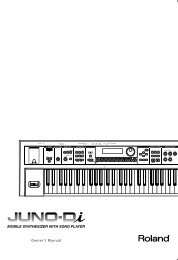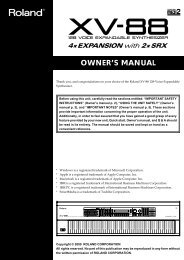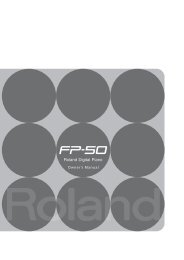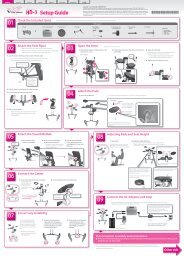You also want an ePaper? Increase the reach of your titles
YUMPU automatically turns print PDFs into web optimized ePapers that Google loves.
Delay (Add echoes to the sound)<br />
Chapter 4. Applying Effects to the Sound (Effects)<br />
Delay is an effect which adds echoes to the sound. It is effective when applied to solo phrases or to densely rhythmic phrases.<br />
Described here is how to set the Delay effect.<br />
Turning delay on/off<br />
Delay is turned on by pressing [DELAY] and confirming that its indicator has lighted. To turn it off, press the button again,<br />
extinguishing the indicator.<br />
* This lets you turn the effect on/off for all parts regardless of other settings.<br />
Adjusting the delay volume for individual parts<br />
Refer to the explanation of “Part Delay Level” in “Modifying the settings of each part” (p. 19).<br />
Making detailed settings<br />
1. Hold down [DELAY] and press [EDIT].<br />
* If the D-FIELD function ASSIGN 2 is set to “DELAY,” you can also access the setting screen by holding down the D-FIELD function<br />
button [ASSIGN 2] and pressing [EDIT].<br />
2. Press [ENTER] to select a parameter.<br />
3. Turn [VALUE] to modify the setting.<br />
4. When you are finished, press [EXIT].<br />
Screen Parameter Explanation Value<br />
TYPE Selecting the type. SHORT, LONG<br />
TIME Adjusts the time from the original sound until<br />
when the delayed sound is heard (the interval between<br />
repeats).<br />
* On the D-2, it is not possible to set a delay time<br />
longer than 1 second. When the delay time is<br />
synchronized to the BPM, selecting a note value<br />
which would make the delay time exceed 1second<br />
will cause the delay time to be halved, and the<br />
delay sound will be heard at 1/2 the specified<br />
interval. In addition, even if 1/2 the length would<br />
exceed 1 second, the delay time will be shortened<br />
to 1/4 the length.<br />
FEEDBACK Sets the amount of delayed sound to be repeated, as<br />
a proportion of the original sound.<br />
HF DAMP Specifies the frequency at which the high frequency<br />
portions of the reverberation will be cut. Lowering<br />
this setting will cause more of the upper frequency<br />
content to be cut, making the reverberation more<br />
muted in tone.If this “BYPASS” is selected, the high<br />
frequency range will not be cut.<br />
OUTPUT Allows you to select a destination for the sound after<br />
reverb has been applied.Selecting LINE outputs<br />
the sound to the OUTPUT jacks on the rear panel;<br />
selecting REV outputs it to Reverb; or selecting<br />
LINE + REV outputs the sound to both the OUT-<br />
PUT jacks and Reverb.<br />
DELAY OUTPUT<br />
LEVEL<br />
This adjusts the volume of the delay sound for all<br />
eight parts (the rhythm part and parts 1-7).<br />
MFX TO DLY LEVEL Applies the Delay equally to each of the parts with<br />
Multi-effects set at ON regardless of the Part Delay<br />
Level for each part.<br />
When “TYPE” is SHORT: 0.1-275 (ms)<br />
When “TYPE” is LONG: 200 (ms)-1 (s), notes<br />
(*1)<br />
0–98 (%) Y<br />
200 (Hz)–8.00 (kHz), BYPASS<br />
LINE, REV, LINE+REV<br />
* 1: 16 (16th note), 8T (8th note triplets), 16. (dotted 16th note), 8 (8th note), 4T (quarter note triplets), 8. (dotted 8th note), 4 (quarter note), 2T (half note<br />
triplets), 4. (dotted quarter note), 2 (half note)<br />
* Parameters with an “X” or “Y” following the value will be selected when using D-FIELD to control the delay (p. 39). “X” can be controlled by moving<br />
your finger to left and right, and “Y” by moving your finger up and down.<br />
0–127<br />
0–127<br />
* This setting does not have any effect on a part<br />
with the MFX switch turned off (p. 19).<br />
X<br />
43<br />
Chapter 4



